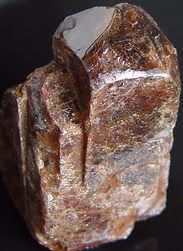Earth's Oldest Known Object on Display
April 8, 2005
By RYAN J. FOLEY, Associated Press Writer
MADISON, Wis. - A tiny speck of zircon crystal that is barely visible to the eye is believed to be the oldest known piece of Earth at about 4.4 billion years old.
 For the first time ever, the public will have a chance to see the particle Saturday at the University of Wisconsin-Madison, where researchers in 2001 made the breakthrough discovery that the early Earth was much cooler than previously believed based on analysis of the crystal. For the first time ever, the public will have a chance to see the particle Saturday at the University of Wisconsin-Madison, where researchers in 2001 made the breakthrough discovery that the early Earth was much cooler than previously believed based on analysis of the crystal.
To create buzz about an otherwise arcane subject, the university is planning a daylong celebration of the ancient stone — capped with "The Rock Concert" by jazz musicians who composed music to try to answer the question: What does 4.4 billion years old sound like?
"This is it — the oldest thing ever. One day only," said Joe Skulan, director of the UW-Madison Geology Museum, where the object will be displayed — under police guard — from 10 a.m. to 3 p.m. "The idea of having a big celebration of something that's so tiny — we're playing with the obvious absurdity of it."
With the aid of a microscope, anyone will be able to check out the tiny grain, which measures less than two human hairs in diameter.
A concert by Jazz Passengers, a six-piece group from New York hired to compose music for the event, will follow on Saturday evening. In posters hanging on campus, the concert is advertised as "a loving musical tribute to the oldest known object on Earth."
Composer Roy Nathanson said the concert will mix humor, jazz music, computer-generated beats, and the occasional rocks being banged together to "follow the geological history of how this zircon came about."
"It's an amazing story. The whole thing is something that captures your imagination," said Nathanson, 53, a saxophonist who spent one year composing the performance.
Analysis of the object in 2001 by John Valley, a UW-Madison professor of geology and geophysics, startled researchers around the world by concluding that the early Earth, instead of being a roiling ocean of magma, was cool enough to have oceans and continents — key conditions for life.
"It's not very much to look at because it's so very small. But to me, the miraculous thing about the crystal is that we've been able to make such wide-ranging inferences about the early Earth," Valley said. "This is our first glimpse into the earliest history of the Earth."
Valley found that the planet had cooled to about 100-degrees Centigrade less than 200 million years after it was formed. Before the research, the oldest evidence for liquid water on the planet was from a rock estimated to be much younger — 3.8 billion years old.
As part of Saturday's event, Valley will display a brand new, $3 million ion microprobe that he and other researchers will use to analyze tiny samples such as the zircon crystal. The hand-built instrument weighs 11 tons and takes up an entire laboratory.
Valley, who has tried to obtain the equipment for 22 years, had to travel to Scotland and Australia while he analyzed the zircon to use equipment there. A federal grant is paying for most of the new instrument.
After the festivities the object will return to its native Australia with Simon Wilde, professor at Curtin University of Technology in Perth, Western Australia, who made its discovery in 1984. The sample will eventually be put on display at a natural history museum in that country.
|
<< Home